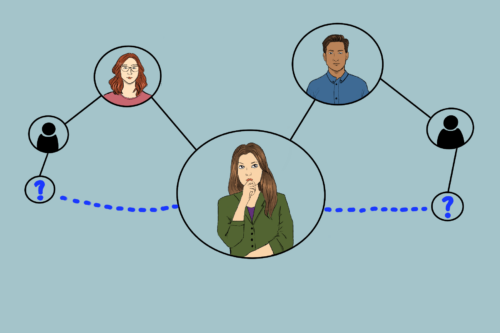Art by Kara Tao.
In 1973, American sociologist Mark Granovetter published a paper that fundamentally changed the field of sociology. The paper, titled “The Strength of Weak Ties,” theorized that weak ties (think casual acquaintances, friends-of-friends, and other arm’s-length relationships) help disseminate new information and provide more job opportunities than strong ties (such as close friends, family, or immediate coworkers).
This phenomenon, which may seem counterintuitive at first glance, happens because weak ties—interpersonal relationships with fewer mutual connections—help expose people to new information and opportunities outside their immediate social bubble. “Weak ties tend to span a broader width of the overall social network of the labor market. Strong ties tend to be redundant because you have access to the same sort of resources, information, and so on,” said Karthik Rajkumar, an applied research scientist at LinkedIn.
For Rajkumar, it was fascinating to see this correlation in action. As a graduate student applying to internships in 2019, he found himself sending out resume after resume, just hoping to hear back at all. (A familiar story to many readers, especially those now looking for jobs and summer opportunities!) “It really made me think: there’s so much more to the job market and the interview process than your resume and your credentials and your interviewing skills. There’s that personal touch—that connection, and that’s something I learned the hard way,” Rajkumar said. This prompted him to ask: what is the effect of social networks on job mobility?
The term “job mobility” means that people in the labor market are able to move to new jobs when they want. “Job transmission” refers to job mobility as a result of connections made. “‘Job transmission’ is this idea that if I connected with you now, am I going to join your company a year down the line?” Rajkumar said.
Rajkumar and his co-authors designed a study to test for a causal relationship between interpersonal ties and job mobility using five years of data from LinkedIn. Their new paper in Science, titled “A causal test of the strength of weak ties,” is the first to conduct a large-scale, experimental study of a causal—not just correlational—relationship between weak ties and employment. More specifically, the researchers used LinkedIn’s People You May Know (PYMK) algorithm, which recommends new connections for LinkedIn users to add to their networks. By adjusting the algorithm, the team randomly varied whether users got weak or strong tie recommendations in the PYMK section. The tie strength between two users was determined by the number of messages sent back and forth and the number of mutual connections they had.
The results empirically validated the theory that weak ties cause increased job mobility. This discovery disproved the “paradox of weak ties,” identified by previous correlational studies that proposed strong ties as the agents behind job mobility. The overall relationship between tie strength, measured by the number of mutual friends, and job mobility was nonlinear, following an “inverted U-shape.” In other words, the weakest ties weren’t the best at increasing job mobility. Rather, moderately weak ties increased job mobility and job transmissions the most. The strongest ties affected job mobility the least.
However, when they looked at the results according to interaction intensity (the number of messages exchanged) as the metric of tie strength, weak ties with low interaction were the most helpful. Interestingly, these results varied by job industry. Weak ties mattered most when applying to jobs in industries that rely on software, but strong ties still held sway in less digital industries. This difference may be due to the importance of up-to-date information in rapidly evolving industries like tech. “Weak ties are conduits for information. They’re very efficient in bridging these information gaps across vast corners of the social network,” Rajkumar said.
So how has this discovery been applied to sites like LinkedIn? One example is the updated “People You May Know” section. Before, the PYMK page simply showed a list of connections. Now, LinkedIn separates these connections into categories—connections from the same school, company, industry, and so on. “A lot of times, I hear people say, oh, I would like to have weak ties, but you know—how would I approach a total stranger? It’s all about finding that commonality, whether it’s your professional interest or mutual connections,” Rajkumar said.
The discovery of a causal relationship between weak ties and job mobility provides important insights for networks like LinkedIn as the labor market becomes increasingly digitized.

